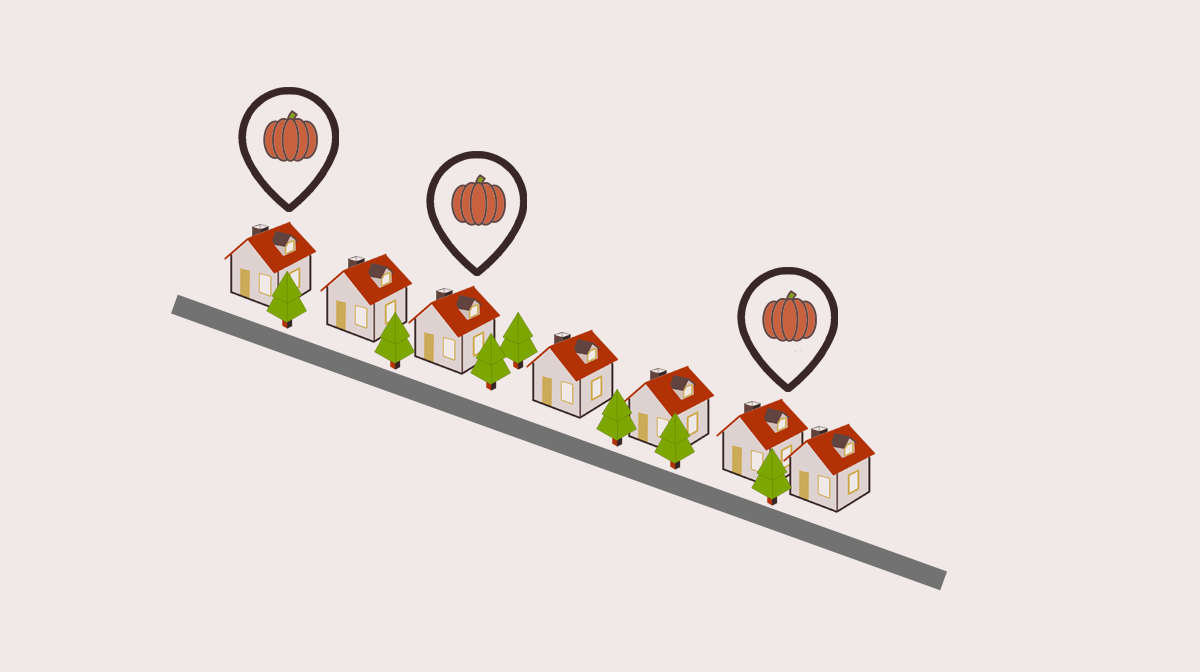It's almost a shame that Chicago's rental season ends on October 1 each year. The end of October is a great time for checking out new neighborhoods, and not just because of the mild weather and pretty autumn trees. It's also the time when people put out pumpkins and Halloween decorations, and those are great indicators of what a neighborhood is like to live in.
Jack-o-lanterns, like most metrics, are not a 100% certain method of gauging a neighborhood's character. After all, there are some very nice downtown neighborhoods with very high density buildings and no room for individual people to put up decorations. Zoning laws mean that apartment buildings are usually clustered together, and homes with yards (and pumpkin-bearing porches) are in a different section of the neighborhood. But in Chicago at least you can walk a block or two and rapidly transition from one type of building to the other.
All told, once you get out of the center of the city, Halloween decor becomes a great benchmark. Here's why:
Pumpkins are cheap.
The average pumpkin costs about $6. Carving it takes a sharp knife but most folks have one of those already. Not everyone carves their pumpkins anyhow - they last longer if they're left intact. Pumpkins are a basic, inexpensive decoration that pretty much everyone can opt into.
Halloween decorations show pride of ownership.
People decorate places that they love. They decorate to show how good they are at feathering their own nest. If you're not planning to stay in one place for a long time you'll probably leave it alone - it's only when you settle down for the long haul that you start taking steps to gussy up the place.
Pumpkins usually mean there are kids with caring parents around.
While some folks like to put out pumpkins well into adulthood, carving a pumpkin with your kids is a pretty standard tradition. If you see a whole bunch of carved pumpkins around, you can be pretty sure that there's not only children but also parents who are willing to spend time with their families.
Halloween isn't restricted to one religion.
Decorating your house and yard is not just a Halloween thing. In fact, Christmas decorations are probably more pervasive - especially outdoor Christmas lights. But Christmas is mostly restricted to those who follow the Christian faith, and those lights take a lot of effort and cost to put up. Halloween, or at least the American-style celebration of Halloween with pumpkins and orange decorations, cuts across religious boundaries with the exception of some extremist sects.
Pumpkins show that neighbors trust neighbors.
If you think your neighbor is going to smash, steal or harass your pumpkin you probably won't leave it outside. A gaggle of gourds in the area shows that the nearby mischief is well-managed.
Pumpkins can give you an indication of the residents' personalities.
Carving a pumpkin is an artistic thing. While many stick to the traditional jack-o-lantern grin, others choose carve references to favorite shows, games or memes on their pumpkins.
Pumpkins can hint at the racial and cultural makeup of a neighborhood.
Halloween may cut across religious boundaries, but the tradition of putting out decorated pumpkins is pretty much restricted to the US and the UK. The absence of pumpkins might not indicate neighbor vs neighbor distrust, but rather a lack of general awareness to US traditions. Neighborhoods with a lot of first generation immigrants or persons of color may skip the whole pumpkin thing altogether.
Sometimes Halloween decorations can show neighborhood organization.
Some neighborhood groups sponsor decorating contests around Halloween, or work together to decorate the whole block. If you see a lot of over-the-top decorations or decorations in public areas, you can be pretty sure there's a local civic group handling it.
The choice of store-bought or handmade decorations gives a hint about occupations and income.
You can buy a ton of decorations, or you can make them yourself. Both take money and time, but store-bought decor requires more money, while handmade ones take more time. A neighborhood where people work white collar jobs will have more glossy-looking yards. Areas with lower incomes or lots of retirees might have more handcrafted decorations.
How many houses and buildings around you are decorated for Halloween? Can you figure out anything else about the people who live inside by looking at their pumpkins? Let us know in the comments!
RentConfident is a Chicago startup that provides renters with the in-depth information they need to choose safe apartments. Help us reach more renters! Like, Share and Retweet us!


